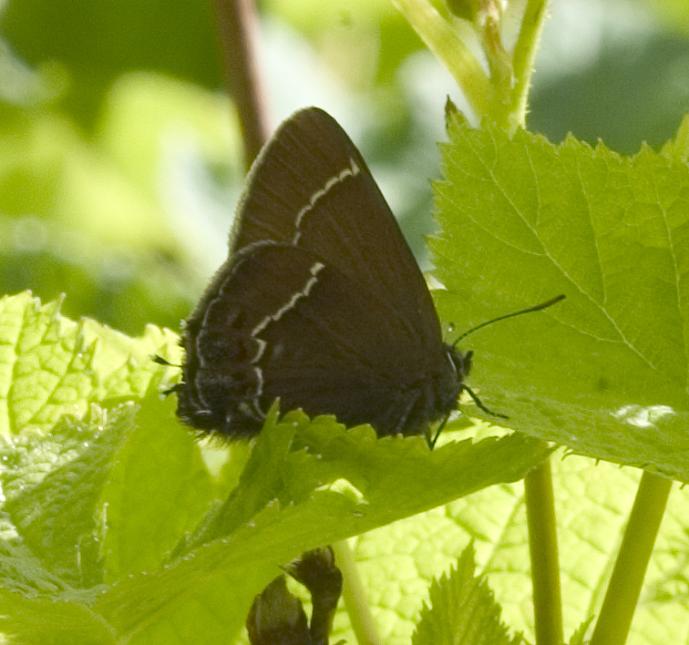Moderate-
High
The population of the Johnson’s hairstreak in Washington is low and the trend is unknown. This lycaenid butterfly species is recognized as a state "Species of Greatest Conservation Need" due to its rare and restricted hostplants [food for caterpillars (larvae)] and habitat types, small number of isolated populations, highly limited range and distribution, and threats to its habitat. Research is needed on this species to understand its life history and quantify specific habitat requirements including vegetation structure, food plant size and density, and key habitat features.
Description and Range
Physical description
The Lycaenidae butterfly family consists of small and often brightly colored species with the common names: copper, hairstreak, elfin, and blue.
Ecology and life history
The Johnson’s hairstreak depends on western dwarf mistletoe (Arceuthobium campylopodum), a plant that parasitizes old-growth western hemlock trees. Eggs are laid and larvae feed on western dwarf mistletoe, which typically grows high up in its host tree. Western hemlock occurs in low to middle elevations; Johnson’s hairstreak has been found in western Washington forests from 100 to 2500 feet in elevation. Small, adjacent forest openings in this landscape often provide additional floral nectar sources and puddling sites.
This lycaenid butterfly completes a single life cycle annually (univoltine). All lycaenids are sedentary butterflies and do not migrate; instead, the species inhabits sites year-round (as egg, larva, pupa and adult), typically moving within only a few hundred yards of their natal locations. Adults emerge from their chrysalids (pupae) during species-specific time periods; the Johnson’s hairstreak’s adult period is June through July.
Both males and females feed by using their long proboscis to sip floral nectar. Males of most species require salts, which they obtain from evaporated puddles and moist soil and animal urine and feces.
Larvae are slug-like in appearance and highly camouflaged in their host species. Many lycaenid larvae engage in mutualistic relationships with ants, known as myrmecophily, which typically consists of ants tending and milking larvae, obtaining nutrition in the form of a nectar-like substance (honeydew) in the process, and also protecting larvae from predators and parasitoids; in some situations, the ants move butterfly larvae or pupae into ground chambers, including their nests. The overwintering stage varies by lycaenid species: Johnson’s hairstreak overwinter as pupae.
Geographic range
The distribution of the Johnson’s hairstreak is limited in part by a combination of its dependence on rare hostplant occurrence within rare habitat types. In Washington, its distribution and abundance in Washington is characterized by small numbers of small, isolated populations. The species' overall range is in mature forests in southwest British Columbia, western Washington, western Oregon, and northern California. In Washington, occurrence has been documented in Jefferson, Lewis, Mason, Pierce, Skamania, and Snohomish counties.
For a range-wide map of conservation status and distribution of Johnson’s hairstreak species, check out NatureServe Explorer.
Climate vulnerability
Sensitivity to climate change
Moderate-
High
Johnson's hairstreak likely exhibits some physiological sensitivity to temperature and precipitation, with inclement weather delaying emergence and reducing diurnal activity. This butterfly may also be sensitive to moisture declines, as it has been documented drinking from puddles. This species is also likely sensitive to climate-driven changes in its larval host plant, dwarf mistletoe, which is a parasitic plant in conifer forests (e.g., western larch), particularly old-growth. Increasing fire frequency, intensity, and severity may reduce dwarf mistletoe abundance in the short-term, reducing habitat availability for Johnson's hairstreak.
Exposure to climate change
Moderate
- Changes in precipitation
- Altered fire regimes
Conservation
Conservation Threats and Actions Needed
- Resource information collection needs
- Threat: Lacking information on current status of known sites and distribution
- Action Needed: Inventory and status assessment
- Agricultural and aquaculture side effects
- Threat: Species habitat is low-elevation, old-growth forest that has been impacted by logging
- Action Needed: Habitat management planning that recognizes importance of forest type and mistletoe species
See the Climate vulnerability section for information about the threats posed by climate change to this species.
Resources
References
Ballmer, G. and G. Pratt. 1991. Quantification of ant attendance (Myrmecophily) of lycaenid larvae. Journal of Research on the Lepidoptera. 30(1-2): 95-112.
Hays, D., A. Potter, C. Thompson, and P. Dunn. 2000. Critical habitat components for four rare south Puget Sound butterflies. Final report to The Nature Conservancy. Washington Department of Fish and Wildlife. Olympia.
James, D. and D. Nunnallee. 2011. Life Histories of Cascadia Butterflies. Oregon State University Press, Corvallis. 447 pp.
LaBar, C. C. 2009. Investigating the use of herbicides to control invasive grasses in prairie habitats: effects of non-target butterflies. M.S. Thesis, Washington State University, Vancouver. 37pp.
Pyle, R.M. and C.C. LaBar. 2018. Butterflies of the Pacific Northwest. Timber Press. 461 pp.
Pyle, R. 1989. Washington butterfly conservation status report and plan. Washington Department of Fish and Wildlife, Olympia. 216pp.
